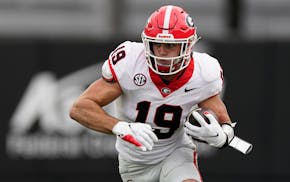Throughout baseball's first century, the template for drawing up a lineup was pretty much gospel: Start with a fast guy who gets on base a lot, back him up with a bat-control artist who specializes in moving runners along, then plug in your sluggers to drive him in. The Twins followed that orthodoxy throughout their history, topping their lineups with speedsters such as Chuck Knoblauch, Luis Castillo, Denard Span.
Those days ended when spreadsheet-reading analysts and lineup-making managers made a collective realization, to wit: "It's never a bad thing," Twins bench coach Derek Shelton said, "to start a game [ahead] 1-0."
That new era at Target Field was inaugurated by Brian Dozier five years ago, and codified this season with perhaps the unlikeliest combination of leadoff hitters the Twins have ever utilized: Outfielder Max Kepler and catcher Mitch Garver. It's a tandem that produced plenty of doubts this spring (and yes, I'm raising my hand here), and has instead proved to be the embodiment of an inspired strategy.
"We had an idea that Max especially would fit really well there, that he would give the lineup some real teeth right from the start. You don't allow a pitcher to ease into the game with a hitter like Max up front," Shelton said of Kepler, who has indeed given the Twins a 1-0 first-inning lead six times this season. "And Mitch, same thing — he's just a real weapon for us wherever he hits."
It works, no doubt. Twins leadoff hitters have scored more runs than any other AL team's, and driven in more than any team's except Houston, where George Springer is having a season that will undoubtedly earn some down-ballot MVP votes.
And the speedy, base-stealing image of a leadoff hitter? Twins leadoff hitters have stolen exactly one base in 2019 (in six attempts), a meaningless sixth-inning swipe on May 23 in a game the Twins were leading 8-2.
"When you construct a lineup, you have to play to your own personnel, and we have tried to do that this year because of how this team scores runs," Shelton said. "Maybe you adjust from year to year, but that traditional thinking, of having a guy who's really fast and steals bases and all that, not many teams think that way anymore. And it's really not a fit for how we score runs."
He means, how they hit home runs, of course. On a team that already has broken baseball's single-season home run record, perhaps no position better illustrates the change than the Twins' leadoff hitters.
Thanks to Kepler's breakout power season — 36 home runs entering the weekend, 16 more than he's ever produced before in a season — this year's Twins have already blown past the franchise's record for homers from leadoff hitters, and they entered the weekend needing just one more RBI to tie the record for runs driven in.
But shouldn't that power be moved down in the lineup, in order to put better on-base guys in front of them? Not necessarily, Shelton said.
"We're happy with how Max has been getting on base. He's been phenomenal against lefthanders, too," Shelton said, though he's frequently moved down in the order to allow Garver to lead off against tough lefties.
"He's drawing walks. He's getting on base. And he's hitting home runs."
The Twins' on-base percentage in the leadoff spot is .342, seventh best in the AL, with Garver's .392 mark in that role somewhat offsetting Kepler's .335 — which is still easily the German's best season yet at avoiding outs.
But their .533 slugging percentage is, by orders of magnitude, the best power showing by a Minnesota leadoff corps, even topping the Dozier years. The previous franchise record was .501, set in 1986 when Kirby Puckett was still a leadoff hitter, and tied in 2017 by Dozier's Twins.
"I don't know if it's less challenging" to draw up a lineup when you have that kind of power at your disposal, Shelton said, "but I can tell you this — it's a hell of a lot more fun."
Phil Miller covers the Twins for the Star Tribune. Twitter: @MillerStrib
E-mail: phil.miller@startribune.com

